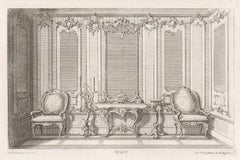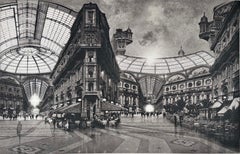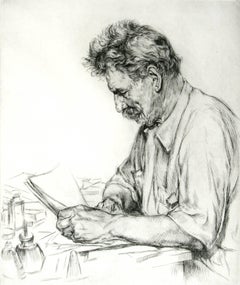Franz Xaver Habermann Art
to
1
Overall Width
to
Overall Height
to
1
1
1
1
1
1
1
1
1
1
1
9,989
2,754
1,378
1,375
Artist: Franz Xaver Habermann
Rococo interior design and furniture, German mid 18th century etching
By Franz Xaver Habermann
Located in Melbourne, Victoria
Rococo interior design and furniture, etching, by Franz Xaver Habermann (1721-1796), circa 1750.
Lettered 'F. X. Haberman, inv. et del. loh. Georg Hertel, excud : Aug. Vind., number...
Category
Mid-18th Century Rococo Franz Xaver Habermann Art
Materials
Engraving, Etching
Related Items
Hidden Cities III: Continuum, by Peter Milton
By Peter Milton
Located in Palm Springs, CA
Peter Milton’s Hidden Cities: Continuum transforms the grandeur of the Galleria Vittorio Emanuele into a layered meditation on architecture, memory, and the passage of time. The Gall...
Category
Early 2000s Contemporary Franz Xaver Habermann Art
Materials
Engraving, Etching
Portrait of Albert Schweitzer.
By Arthur William Heintzelman
Located in Storrs, CT
Portrait of Albert Schweitzer. Etching. 11 3/4 x 9 3/4 (sheet 16 1/4 x 14). Illustrated: Beall, American Prints in the Library of Congress, page 205....
Category
1950s American Modern Franz Xaver Habermann Art
Materials
Etching, Drypoint
$750 Sale Price
50% Off
H 11.75 in W 9.75 in D 0.5 in
Returning to the Stable.
By Edmund Blampied
Located in Storrs, CT
Returning to the Stable. 1920. Drypoint. Appleby 64. 8 3/4 x 12 1/4 (sheet 11 7/16 x 16 1/8). Edition 100. A rich impression printed on cream laid paper wi...
Category
1920s Modern Franz Xaver Habermann Art
Materials
Drypoint, Etching
Points of Departure: Mary's Turn, by Peter Milton
By Peter Milton
Located in Palm Springs, CA
Peter Milton’s Mary’s Turn reimagines a scene where Mary Cassatt and Edgar Degas engage in a game of billiards, reflecting their real-life friendship and rivalry. Cassatt leans forwa...
Category
1990s Contemporary Franz Xaver Habermann Art
Materials
Engraving, Etching
France at her Furnaces
By James McBey
Located in Storrs, CT
1917. Etching. Hardie 175. 8 x 15 (sheet 10 1/8 x 16 15/16). Edition 76. Slight mat line; otherwise excellent condition. A rich impression printed on antique laid paper with full m...
Category
1910s Modern Franz Xaver Habermann Art
Materials
Drypoint, Etching
Night Time in a Stable.
By Edmund Blampied
Located in Storrs, CT
Night Time in a Stable. 1927-28. Drypoint. Appleby 131. 10 1/8 x 12 1/8 (sheet 11 1/2 x 16 1/2). Edition 100. Illustrated: Print Collector's Quarterly 25 (1...
Category
Early 20th Century Modern Franz Xaver Habermann Art
Materials
Drypoint, Etching
La diligence de Beaucaire
By Félix Hilaire Buhot
Located in Middletown, NY
Paris: Lemerre, 1880.
Etching, drypoint, aquatint (dust ground and spirit ground), spit bite, and roulette in black on cream laid paper with a deckle edge, 6 3/4 x 4 1/2 inches (170 x 112 mm), full margins. Third state (of 3). An illustration from Alphonse Daudet's, Lettres de mon moulin, Paris, 1880. In very good condition with some light uniform toning and two areas of paper tape at the top right and left corners on the verso (from a former mount). With the 1921 J.H. de Bois circular ink stamp in green ink in the lower right margin on the recto (Lugt L.733).
[Bourcard 110].
A note regarding the provenance:
J. H. de Bois was a well known late-19th century modern art...
Category
1880s French School Franz Xaver Habermann Art
Materials
Laid Paper, Drypoint, Etching, Aquatint
Parmigiani Amica: An 18th Century Engraving and Etching by Strange After Mazzola
Located in Alamo, CA
This is an 18th century engraving and etching entitled "Parmigiani Amica" by Robert Strange after a painting by Girolamo Francesco Maria Mazzola, better known as Parmigianino, who lived during the Renaissance period. It was published in London in 1774. As the inscription states, the painting was in the collection of the King of Naples at the time the engraving was made. The engraving depicts a half-length portrait of a young woman, known as Parmigiani's Amica (meaning "female friend" in Italian). She is depicted wearing a simple but elegant dress with a low-cut neckline, which reveals her delicate features and graceful neck. Her hair is arranged in a simple yet stylish manner. She is turning to the right to look lovingly at her infant, which she is holding with her right arm. She is touching the baby's mouth with her left hand. The background of the engraving is plain and unadorned, allowing the viewer to focus entirely on the subject of the portrait. The result is a beautiful and timeless image that captures the essence of Renaissance portraiture.
The engraving is printed on watermarked paper. The sheet measures 16.25" high and 12' wide. The sheet is adhered to paper in its upper corners and it has been removed from the paper in its lower corners. There is some mild discoloration and some wrinkling in the margins, including the lower inscription area, and a small dark spot in the upper margin, which may represent a drop of ink occuring at the time of printing. These issues do not involve the image, which is in very good condition. The print is held by several museums and institutions, including: The Metropolitan Museum of Art in New York, The British Museum in London, The Royal Museums of the UK, The British National Trust...
Category
Late 18th Century Franz Xaver Habermann Art
Materials
Engraving, Etching
$1,500 Sale Price
20% Off
H 16.25 in W 12 in
Interiors I: Family Reunion — A penetrating scene with a hidden homage to Eadwea
By Peter Milton
Located in Middletown, NY
Interiors I: Family Reunion
1984
Resist ground etching and engraving on BFK Rives wove paper, 20 x 36 inches (501 x 913 mm), full margins. Signed, titled, dated and numbered 49/175 in pencil, lower margin. In excellent condition with minor mat tone. A luminous, rich, and well-inked impression of this haunting image, with astonishing detail and depth. Framed handsomely under museum grade glass with archival materials in a solid wood frame with silver finish. [Milton 107]
Intended to be a stand alone image in its inception, Family Reunion ended up spawning seven additional images, and became a sort of Primo Pensiero in the sprawling, masterpiece suite now known as Interiors. The suite took eight years to complete, and consists of works of varying format, psychological intensity, and subject matter. The thematic darkness in the eight images waxes and wanes, and Milton intentionally included several interlude works to lighten the tension he felt while composing several of the darker images. The first two in the series, Family Reunion, and Hotel Paradise Café, were meant to be companion pieces. The equilibrium of each composition is anchored on a central brooding figure; a man (perhaps based on a Thomas Eakins portrait of the American anthropologist Frank Hamilton...
Category
1980s American Modern Franz Xaver Habermann Art
Materials
Engraving, Etching
Soup
By Edmund Blampied
Located in Storrs, CT
Soup. 1920. Drypoint. Appleby 65. 9 x 8 1/8 (sheet 15 x 11 9/16). Edition 100. Illlustrated: Print Collector's Quarterly 13 (1926): 85. Signed in pencil.
Edmund Blampied was a painter, etcher, lithographer and sculptor. Born in 1886 to a family of three boys in St. Martin, Jersey, Blampied became interested in drawing at an early age. After visiting the studio of John Helier Lander in 1899, Blampied decided to make a career as an artist. In 1903 he went to London to attend Lambeth Art School, where he studied etching under Walter Seymour.
In 1905, he joined the Daily Chronicle as an artist. In that year he was awarded a scholarship to Bolt Court Scool of Photo-engraving and Lithography.
In 1912 he left the Chronicle and established his own studio. He earned a living by illustrating novels and short stories.
In 1913, he had his first exhibition at the Leicester Gallery in London. The following year he married Marianne Van Abbé.
During the 1920's, he became a member of the Royal Society of Painter-Etchers and Engravers. During the 1920s Blampied became a member of the Royal Society of Painters-Etchers and Engravers and exhibited in London to critical acclaim. He produced a folio of comic drawings in the 1930s which was published in New York in 1934 and another that was published in London in 1936. The Keeper of Prints and Drawings at the British Museum published a mongraph on his work. His London exhibitions were highly successful.
In 1938, he moved to Bulwarks, St.Aubin in Jersey, but at the onset of the Occupation, had to relocate to Route Orange, St. Brelade. remained there throughout World War II during the German Occupation, despite the fact that his wife was Jewish. During the Occupation he designed bank...
Category
1920s Modern Franz Xaver Habermann Art
Materials
Drypoint, Etching
A Scene in the New Farce —as performed at the Royalty Theater
By George Cruikshank
Located in Middletown, NY
A Scene in the New Farce —as performed at the Royalty Theater
London: George Humphrey, 1821.
Etching and engraving on cream wove paper with extensive hand coloring in watercolor. 9 5/8 x 13 3/4 inches (244 x 348 mm), trimmed at the platemark. A beautiful impression of this large, intricate print...
Category
Early 19th Century Franz Xaver Habermann Art
Materials
Watercolor, Engraving, Etching
$1,800
H 9.625 in W 13.75 in
Jean-Honore Fragonard-L'Occasion Rococo Vintage
By Jean-Honoré Fragonard
Located in Brooklyn, NY
Drawings by French Masters of the XV-XVIII Centuries. From a selection of 40 reproductions of the originals preserved in the Albertina Collection in Vienna. With an introduction and...
Category
1930s Rococo Franz Xaver Habermann Art
Materials
Offset
Franz Xaver Habermann art for sale on 1stDibs.
Find a wide variety of authentic Franz Xaver Habermann art available for sale on 1stDibs. You can also browse by medium to find art by Franz Xaver Habermann in engraving, etching and more. Not every interior allows for large Franz Xaver Habermann art, so small editions measuring 15 inches across are available. Customers who are interested in this artist might also find the work of and Matthaeus Merian. Franz Xaver Habermann art prices can differ depending upon medium, time period and other attributes. On 1stDibs, the price for these items starts at $165 and tops out at $165, while the average work can sell for $165.


